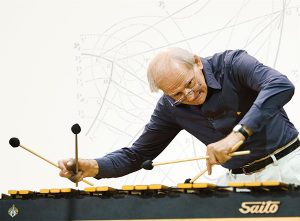 It’s fair to say Department of Chemical and Biological Engineering emeritus professor Ken Jolls has led a double life. It might be more graceful to call him a “renaissance man.” But in a world where science and the arts are strange bedfellows, Jolls has proven that you can successfully embrace both.
It’s fair to say Department of Chemical and Biological Engineering emeritus professor Ken Jolls has led a double life. It might be more graceful to call him a “renaissance man.” But in a world where science and the arts are strange bedfellows, Jolls has proven that you can successfully embrace both.
After falling in love with music at a young age Jolls had his sights set on a career in music performance until fate intervened prior to his senior year at the Indiana University School of Music. In 1954 he contracted polio and spent three months in an iron lung in his native North Carolina, followed by a long period of physical challenges, some of which became lifelong.
But even polio could not keep Jolls from reuniting with music during his recovery. He became involved with the popular Duke University big band, The Ambassadors. That helped lead to a bachelor’s degree in music from Duke. But with a desire to also have training in a more “practical” field, Jolls decided to pursue a second bachelor’s degree at North Carolina State. He’ll tell you he closed his eyes, pointed to a spot in the course catalog and his finger landed on “chemical engineering.” “I said, ‘Well, we’ll try this.’” It turned out pretty well. Jolls the musician at first felt like a fish out of water. But he pressed on. He received a B.S. from North Carolina State and a Ph.D. in chemical engineering from the University of Illinois in 1965. After teaching at the Polytechnic Institute of Brooklyn, in New York City, Jolls moved to the chemical engineering faculty at Iowa State, where he taught and researched for more than 40 years.
But the music has always been there too. “I’ve tried to quit my music habit many times, but it doesn’t work,” he says. He has played piano, guitar, the vibraphone and the marimba, all in many different venues, and those mallet percussion instruments became a bedrock in his life. “I work in science with chemistry and physics, but sometimes I just feel that I need more,” Jolls says. “But when I sit down and play music, it brings me back. And when I play with a group of other musicians, it’s euphoria. A lot of people don’t have the opportunity to feel that in their lives.”
Jolls’ music interest gets most of the press, but there’s another passion he’s developed: following the philosophy that science and art can coexist. It’s called “cognitive art.” And in particular, it applies to the chemical engineering field of thermodynamics, something that Jolls taught from the outset in his academic world. There’s a school of thought that entropy (and other thermodynamic functions) have geometrical analogies and these complex quantities can be turned into unique, visualized objects: thermodynamics represented as art. Jolls has traveled this road since the early 1970s – at ISU, at University of California, Berkeley, and Cornell. Just in the last year he has created a research poster on the subject called “Engineering, Entropy and Art, The Visual Side of Thermodynamics.”
“Expressing such ideas through mathematics alone yields complex equations that befuddle nearly everyone. Yet visualizing them conveys the practical meaning without demanding theoretical depth,” Jolls said in a 2001 editorial to the New York Times. But he went on to say, “Our educational system does not approve. Right-brain methods take a back seat to traditional science teaching, which emphasizes rules and mathematics. The two cultures are still far apart in most science classrooms.” And in what could be called a commentary on his own life: “Let us teach our youth to think with their eyes open.”
